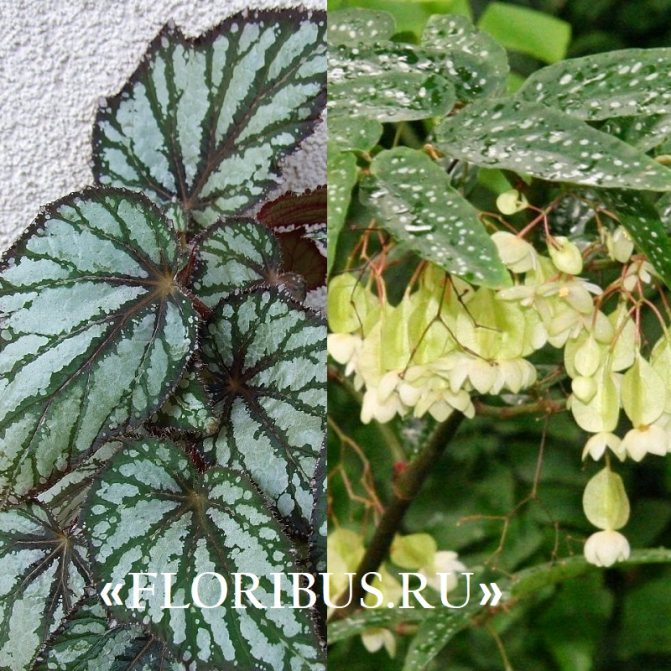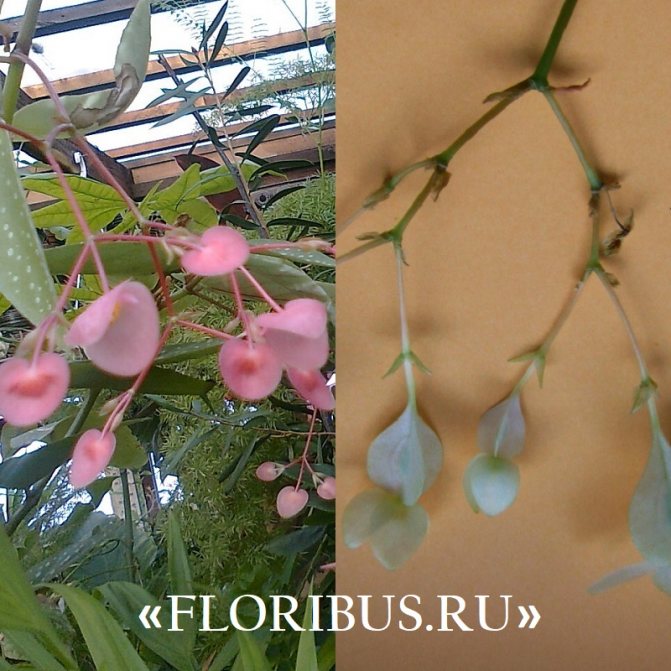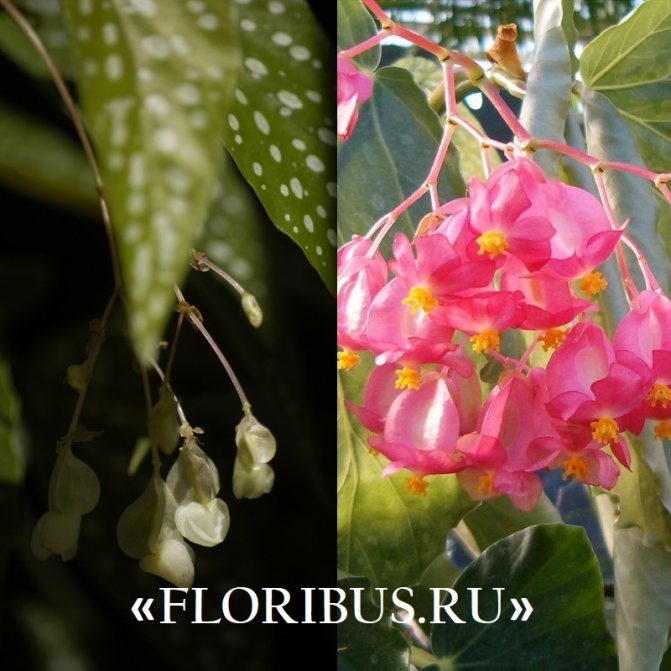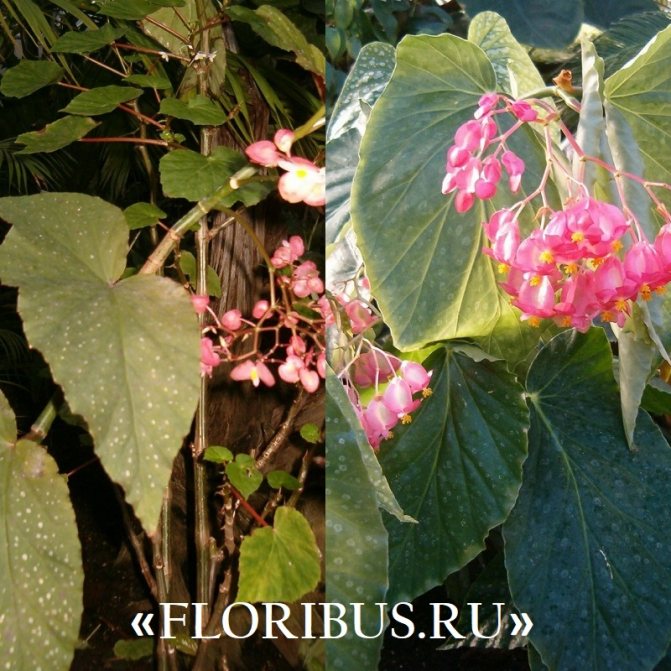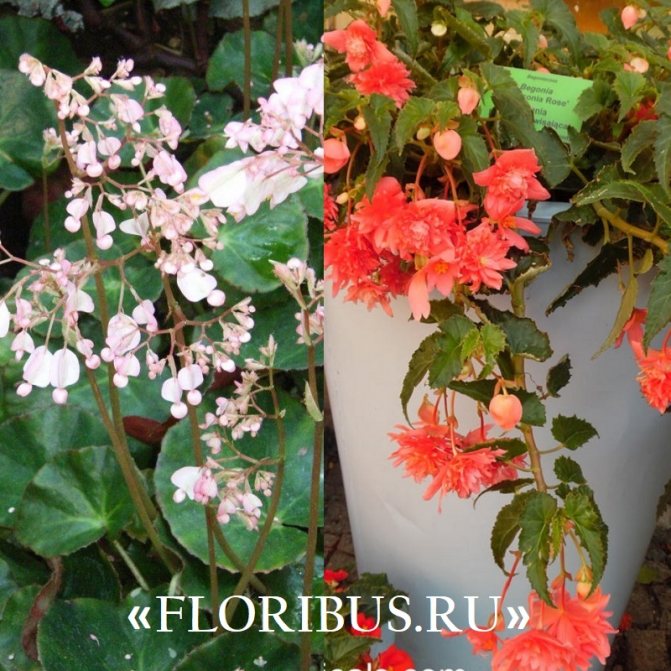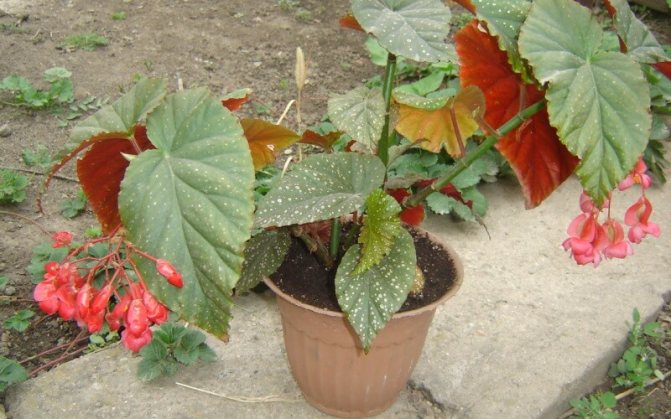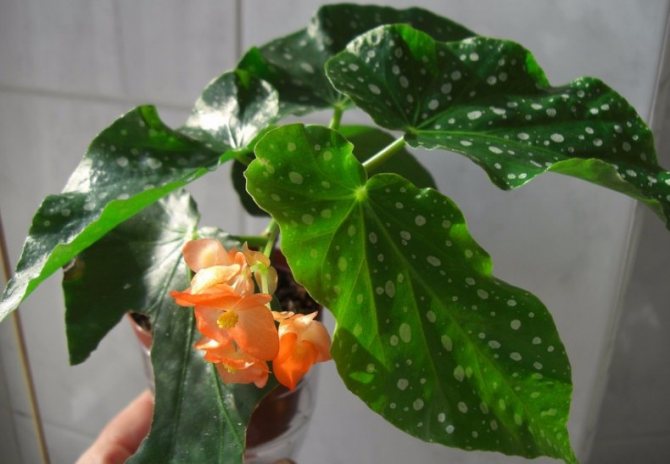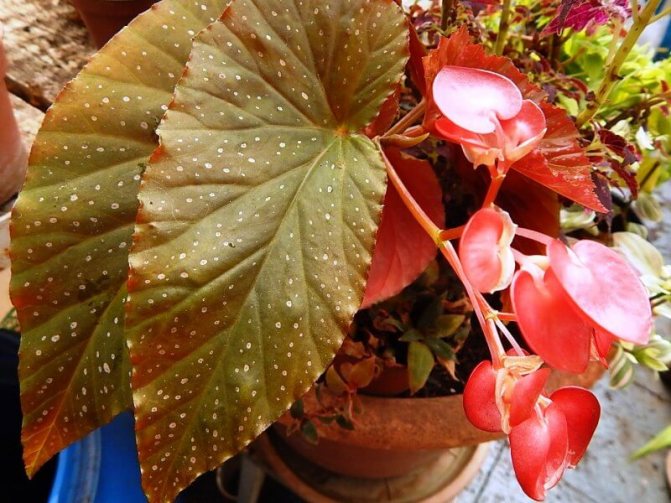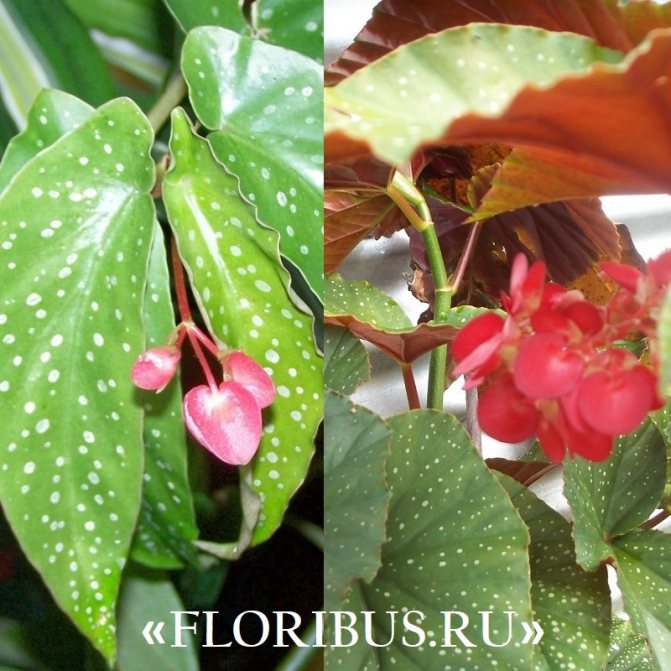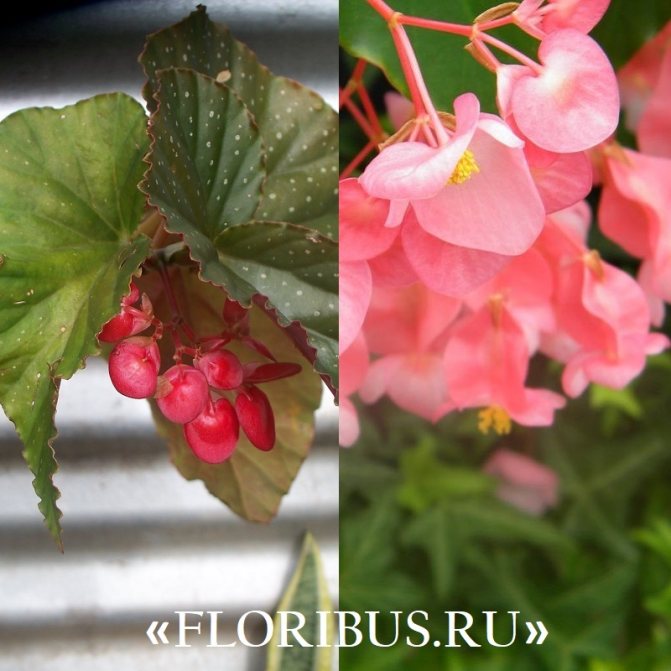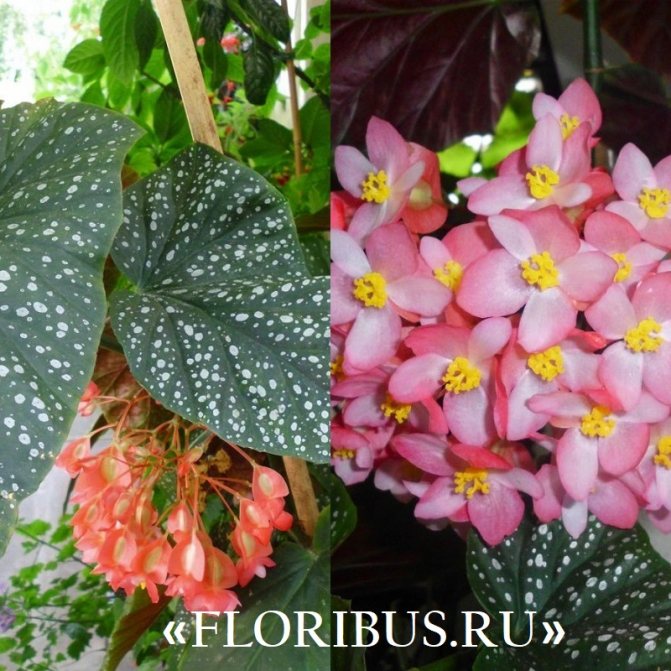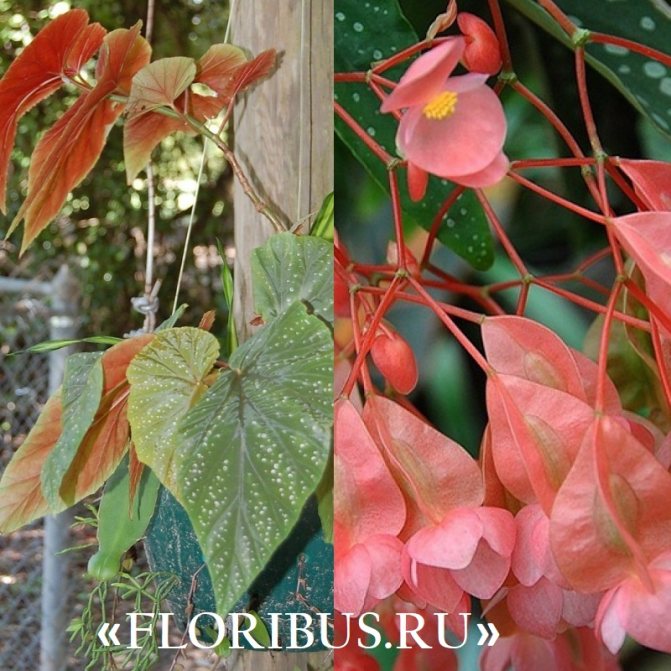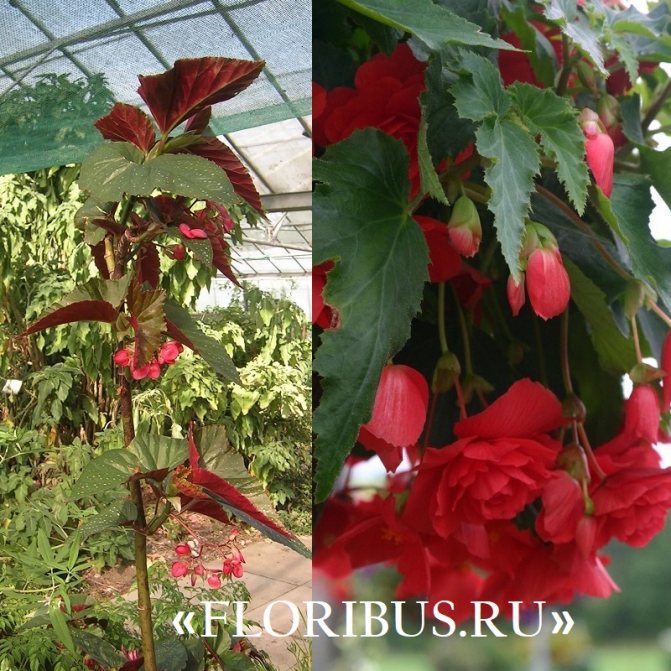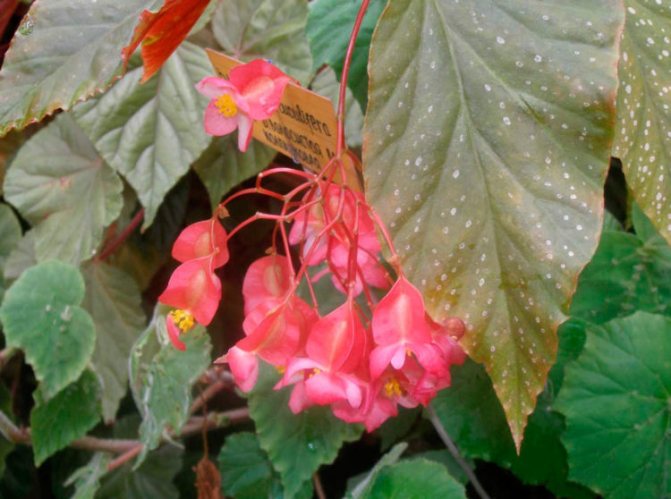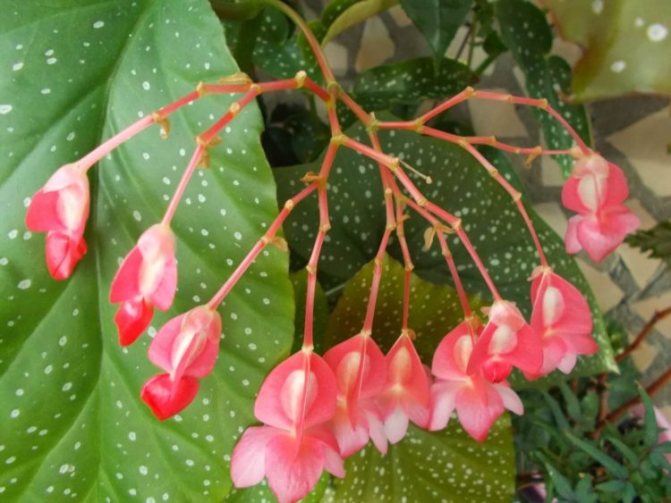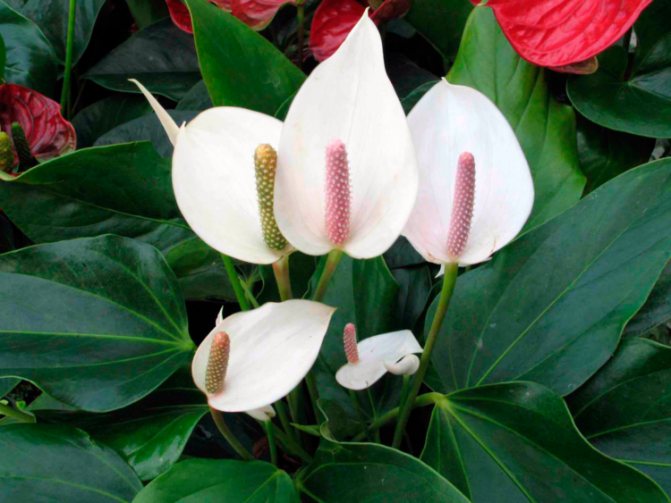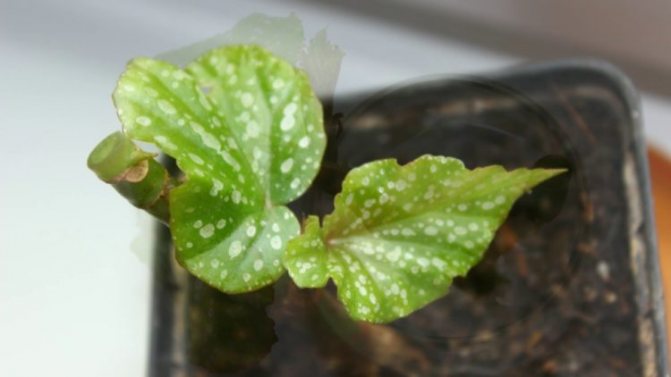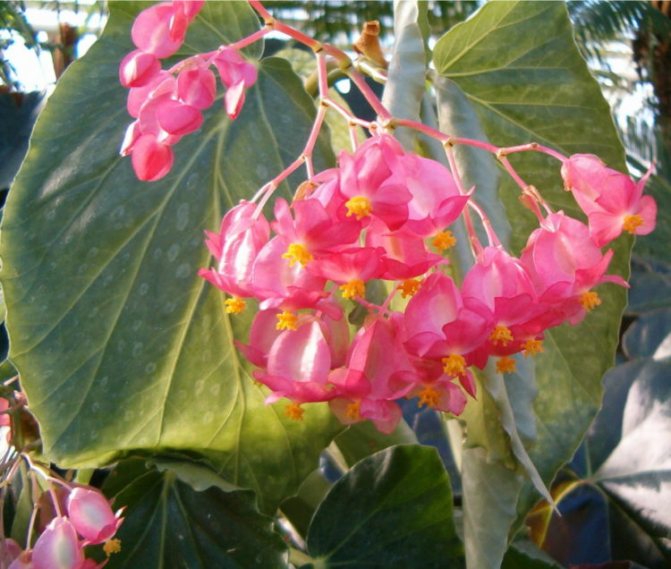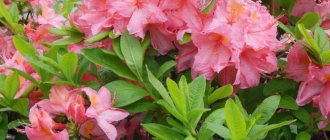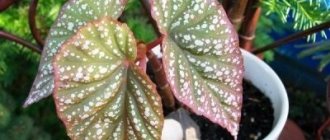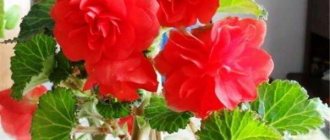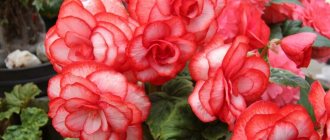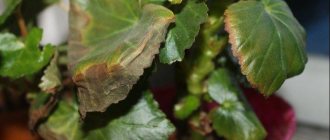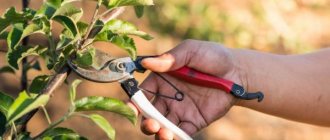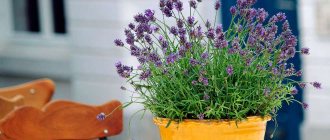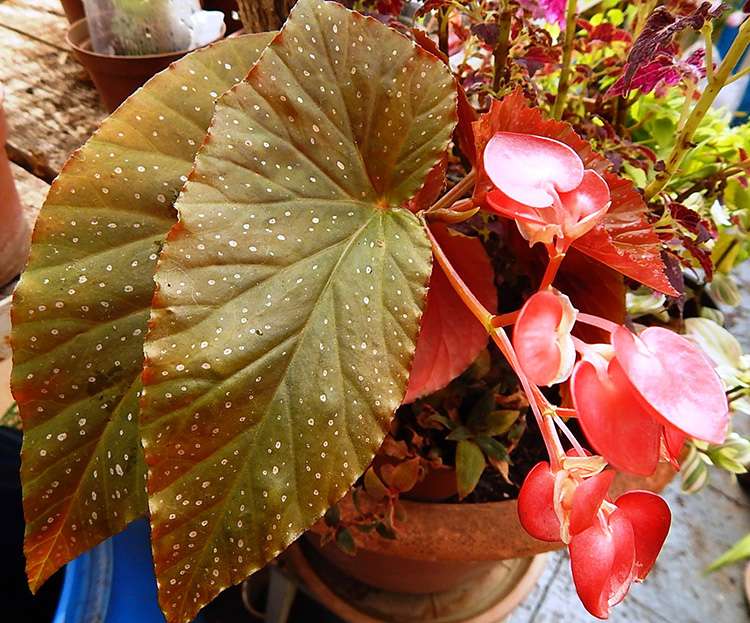
Begonias are annual and perennial indoor plants in the form of shrubs and semi-shrubs belonging to the family of the same name. These crops are characterized by an asymmetric leaf shape and a multi-colored color of the flowering parts. Blooms are brightly colored, have an irregular shape, and the fruits develop in the form of bolls. Depending on the variety, plants reproduce by dividing rhizomes or tubers.
Does begonia need pruning?
Left to itself, this plant loses its decorative effect: the stem stretches out, the shoots become thinner, the leaves shrink, the flowering is minimal.
- How to properly prune begonia:


- We need to think about the formation of a plant at the stage of a young flower. When a young begonia reaches a height of about 6-7 cm, the top is cut off with a sharp knife. This is done to stimulate the development of side shoots.
- After this procedure, the number of waterings should be reduced until the intensive growth of the plant begins.
- As soon as the lateral shoots reach a length of 10 cm, their tops are trimmed. It is important to make sure that the stem shortening is over the bud, which points outward.
- This completes the formation of a young bush. You can from time to time shorten the elongated stems or remove dried shoots to maintain the desired crown shape.
When should a begonia be pruned?
Low air humidity or improper watering
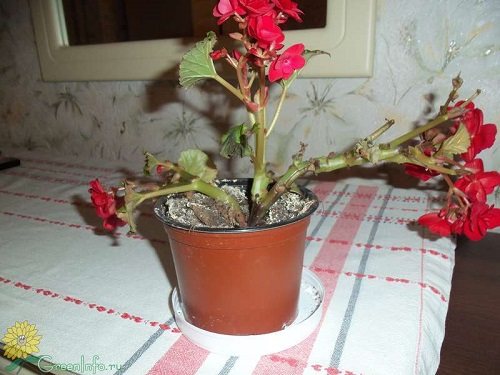

Dry air has a bad effect on begonia, the leaves begin to dry out at the edges and over time it will stop blooming altogether. To increase humidity, you can put a jar of water on the windowsill, or hang a damp towel on the radiator.
And the plant will perfectly respond with flowering to an open aquarium standing next to it.
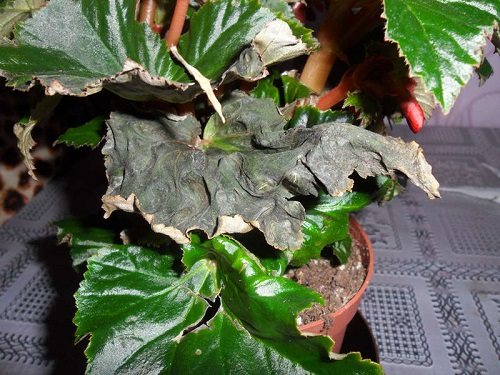

As for watering, with a shortage of water or an excess of moisture, begonia dies. You can try to save at least a few branches: cut off the still living stems and put them in the water. After rooting, they are planted.
Should you prune begonias for the winter?
Opinions on this matter are divided: someone believes that there is no point in pruning, while other growers cut the leaves every fall. It is imperative to prune tuberous begonias, in other species, it is still desirable to cut off the green part. This is done to keep the plant calm during the winter. But there are also varieties that do not need pruning.
How to properly prune begonias for the winter?


With the onset of autumn, the number of watering is reduced in room tuberous begonias. After the leaves dry out, the aerial part of the plant is cut off, leaving 1-2 cm. After that, the flower pot must be placed in a place for wintering. It should be a cool, dark place with a temperature not higher than + 15C... For this, a basement, a loggia is suitable, and in apartment conditions you can put it under a bath. From time to time it is necessary to water it in order to prevent the soil from completely drying out.
When to prune begonias for the winter?
Best time for circumcision is October... This period is considered optimal. Indeed, in February-March, the flower will "wake up" again after hibernation. And the six months that the plant will spend at rest is quite enough to rest, gain strength and, in the summer, please with its unusually beautiful flowering.
Violation of the timing of the rest period
Like every plant, begonias need a dormant period during which they will rest before the next flowering. If it was not there at all, or the begonia woke up ahead of time, it will not have the strength to bloom again. You need help and set a rest schedule. With abundant flowering in winter, the summer three months are left for rest. With the arrival of summer, move the pot to a cool place in the shade with a temperature of no more than 17 degrees and reduce watering. Also, reduce the daylight hours to 7 hours and cover the begonia on top after this time has elapsed.
To bring a flower out of hibernation also gradually - to increase the duration of daylight hours and watering, to increase the temperature regime.
Should all begonias be pruned?
Varieties, which do not need to be trimmed: royal rex and its hybrids, ever flowering.
Thick-bore groups do not need to be trimmed, this is done only when necessary.
Have ampelny need cut off only the apical stems to stimulate the development of lateral shoots.
Bush cut off, choosing a place above the bud, by 5-7 cm. New young stems will develop from such "stumps". Pruning usually occurs in the spring, after the foliage has dropped.
Landing
Where?
It is important when planting coral begonias to choose the right growing container. A clay pot works best. - durable, without chemical impurities, slowly heating. In addition, plants in clay and ceramic pots look more natural.
How?
Drainage is laid at the bottom - pebbles or expanded clay, soil is poured on top. It is better to use a light, water and air permeable nutrient mixture.
If it is not possible to buy ready-made soil, you can take ordinary soil and, to make it looser, add a little perlite or vermiculite. Make a small indentation in the soil of the pot and carefully plant the plant. To quickly harden the stalk, immediately water the soil abundantly.
Pinching begonia
This method allows you to achieve the decorative effect of the bush and will help to form the crown of the chosen shape: spherical, bush, pyramidal, etc.
How to pinch begonia correctly?
This procedure should be done in autumn or spring, that is, either before flowering or after. On the main stem, you need to find the upper growth point and pinch it off by 1-2 cm. After 2-3 weeks, active growth of lateral shoots will begin.
As soon as begonia appears in your house, you should immediately think about its future. It is circumcision and pinching at an early age that will help maintain a beautiful, spectacular, aesthetic appearance of the plant. And it will delight you with its beauty and splendor for a long time!
What to do if begonia does not bloom with double flowers
The double flower is truly beautiful and unique, which is a distinctive feature of begonias. But it so happens that instead of the expected flower, the simplest ones grow. This problem is especially common in tuberous plants. There are several main reasons why this may be due to:
- the tuber has insufficient strength, especially for young plants that bloom for the first time. This is due to an insufficient dormancy period of the plant and improper reproduction.
- lack of strength in the plant itself due to illiterate care.
- one should not exclude such a symptom as an error in production, especially for those seeds that were purchased in the store. Therefore, it is better to purchase the plant itself.
Note! It is worth revising the care and waiting for the next flowering period, maybe the begonia will gain strength and give flowers the desired properties.
Useful video
Video with details of pruning Begonia:
Useful material Below is a list of articles that might interest you.
If you find an error, please select a piece of text and press Ctrl + Enter.
Begonia is a common indoor flower that is grown both in small apartments and in huge greenhouses, where the plant reaches two meters in height. There are about 1600 species of it in the world, and today we will talk about one of them. You will learn what coral begonia is, how it differs from other species, how to plant it correctly and how to get a beautiful flowering plant.
Reproduction (breeding methods)
- This representative of the plant kingdom can reproduce:
- seeds
- cuttings
- dividing the bush
The most common breeding method for coral begonias is cuttings. To use it, it is necessary to cut non-flowering stems from the plant in the spring-summer period with a knife, the length of which should be at least ten centimeters, under the lower leaf. The lower leaves need to be torn off, and the cuttings should be placed in small containers pre-filled with a mixture of wet peat and coarse sand, taken in equal parts.
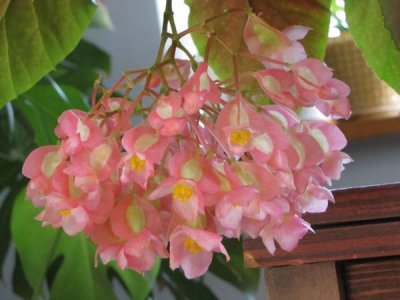

Water the cuttings, and then cover them with plastic wrap, securing it to the pots with an elastic band. Before the roots appear, the cuttings should be placed in a room where the air temperature is at eighteen degrees Celsius.
Plant lifespan
On average, a guest from the tropics lives for about four to five years, but if you breed it using stem cuttings, it can live much longer.
Botanical description
Coral begonia Is a separate species of ornamental plants that belongs to the genus Begonia. Its coral variation came to us from the tropical forests of Brazil, where the flower grows up to 1.5 m in height. At home, the shrub has a height of 0.6-1 m.
The flower has an erect stem, the leaf plates can be colored in various shades of green, have an alternate arrangement, the length is up to 20 cm, and the width is up to 7 cm.The leaves are covered with silvery and milky blotches. The shape of the leaf plates can be oval, indented, or elongated.
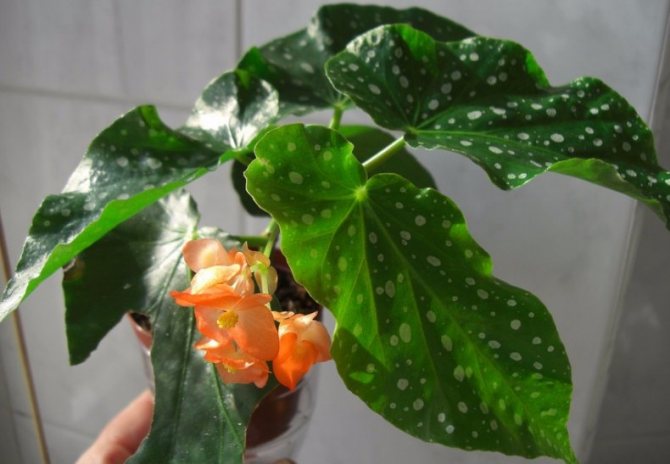

Biological description and photo
Almost all types of begonias are perennials, and coral is no exception. It stands out for its characteristic leaves with a pronounced elongated shape. Interestingly, they often have completely different sides: the outer one is painted in the usual green tones. But the opposite is a rich burgundy or cherry color. Of course, this feature only attracts more attention to such an unusual plant - coral begonia.
Well, if you also take into account the fact that this houseplant gives beautiful flowers of coral color, then such a begonia can no doubt be added to the list of favorites of a home flower garden.
Most often begonia pleases with its coral flowers in spring. Although, if you create the right conditions and follow the simple rules of home care, it will bloom in the winter. But how wonderful it is to wait for delicate petals, for example, on New Year's Eve. And besides, they have a rather pleasant smell. Some gardeners have also tasted the flower stalks: it is noted that they have a pleasant sour taste.
Usually the size of shrubs varies widely: about 40-100 cm.It is interesting that in natural conditions a bush can grow up to 1.5 meters, and flowers in the tropics, where coral begonia comes from, grow larger (as, for example, in the photo ).
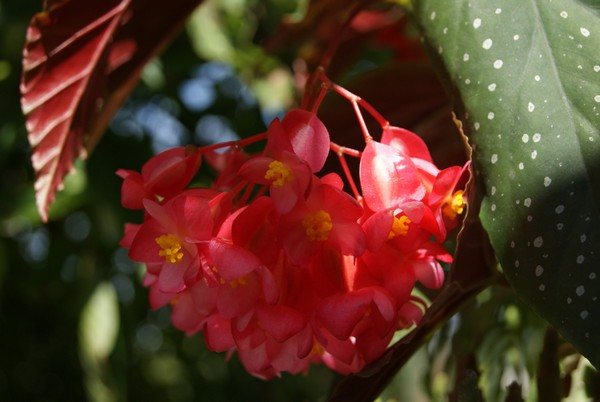

And at home, it is not quantity that wins, but quality. Bunches of coral flowers interspersed with angel wings are truly a sight to behold. And if you imagine that you can admire it all year round, you will simply have an irresistible desire to learn more about the rules for caring for coral begonia at home. This is described in detail below.
Flowering features
Most often, flowering occurs in the spring, however, subject to temperature conditions, begonia can bloom at any time of the year. The buds are formed from fused petals, which are colored in various shades of red (very rarely, in white). The inflorescences resemble bunches of berries.
This variety of begonias is prized precisely because of its pleasantly smelling flowers, which have a not too harsh aroma. It is interesting that the peduncles have not only a pleasant smell, but also a good taste, which gives off sourness.
Preventive measures
It is advisable not to bring the problem to treatment, because you can prevent abnormal development by observing simple rules for prevention. The main points of the activities are aimed at pest control, because the main parameters of care have already been presented.
- rotten and yellow leaves should be removed regularly;
- carry out the spraying procedure using a spray bottle. The water should be clean, preferably separated and at room temperature;
- if there is a tendency to an increase in yellow, dry or rotten leaves - begin the introduction of fertilizers rich in vitamins and minerals. Before that, carefully studying the rules of administration and dosage;
- if you smell rot or whitish bloom, you need to treat the plant with a weak solution of potassium permanganate;
- harmful bacteria can cause a loss of strength of the stems; in order to avoid this, it is necessary to periodically process begonia with a solution of Bordeaux liquid;
- prevention of viral diseases is also carried out with a weak solution of manganese.
Observing preventive measures, the gardener will save himself from questions about why begonia does not bloom and what to do. Caring for begonias is quite simple and will not take you much time, while flowers of various colors (red, orange, yellow) in combination with emerald greens will delight you throughout the winter period or will be a great addition to your garden landscape design.
Growing coral begonias at home
Now let's talk about what conditions are necessary for growing a flower at home. Let's figure out the main indicators.
Substrate and fertilizer
The easiest way is to purchase ready-made soil for violets at a flower shop, since it is extremely problematic to find components for optimal soil in urban conditions. If you want to make the substrate yourself, you will need 1 part peat, 1 part compost, 1 part river sand (coarse) and 2 parts garden soil (top layer).


Be sure to form a drainage layer of gravel or small pebbles at the bottom of the pot. Its thickness must be at least 1.5 cm.
As for fertilizers, there is no need for them if you change the substrate every year. Optionally, you can feed the plant with potassium humate, which provides the appropriate mineral to the plant.
Lighting
For a flower, it is important that there is no direct sunlight, which causes burns on the leaves. The flowerpots should be placed so that only diffused sunlight falls on them. Partial, but not strong shading is acceptable.
Temperature
It should be said right away that begonia does not tolerate drafts, which is why it begins to hurt and wither. For this reason, place it in a location where air flow is minimal.
As for the temperature, it should be in the range of 17-25 ° С. If the temperature drops below 13 ° C in winter, the flower may die.
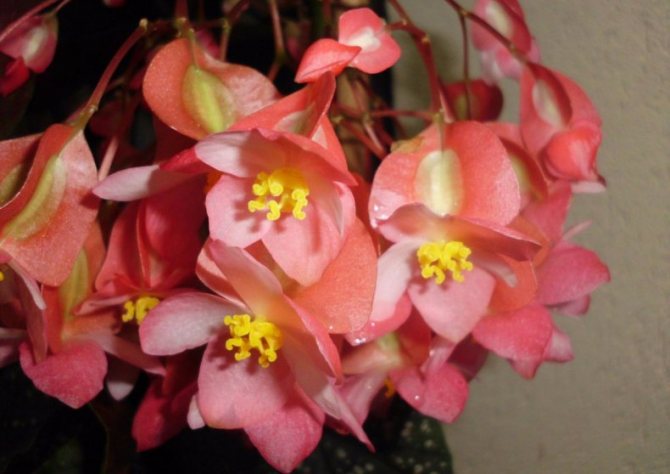

Care: moisture and watering
We move on to caring for the flower, and start with moisture and watering.
In order not to make a mistake that will lead to the death of the plant, it is always worth remembering the following: it is better not to water the flower again than to fill it completely.
The fact is that begonia has fleshy leaves, through which it gets rid of excess moisture. However, with a regular excess, decay of the root system very quickly occurs, which leads to the drying of the flower. Of course, a plant cannot survive without water, but it will be easier to "reanimate" begonia, which has been without water for a long time, than a plant with decayed roots.
Water the plant regularly in summer. If the top 2 cm of the substrate is dry, it is worth moistening the soil. If they are wet, it means that watering should be postponed.
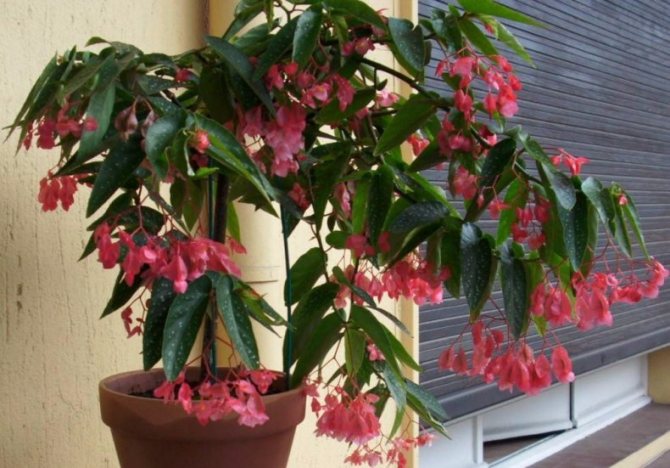

In winter, the amount of applied water is limited, especially if the room temperature drops to the minimum described above. In this case, an excess of moisture, even a slight one, will cause hypothermia of the roots, which will result in the appearance of various diseases.
Pruning
Pruning is carried out both in order to rejuvenate the plant and so that the aerial part is formed correctly.
Shoots and stems can be shaped like a ball, pyramid, or bush. You should start pruning only when the stem reaches 10 cm in length. Shorten it to the length you need, then wait until the lateral shoots grow so that you can complete the formation of the aboveground part.
The presence of pests


If you put the indoor begonia outdoors for the summer, when it is transported back to the house, it is thoroughly examined for the presence of pests. If aphids, spider mites and other harmful insects are found that take away the strength necessary for flowering, immediately treat the begonia with special means.
How to care for begonia so that it blooms more often, the video will show
I bought her as a small sprout, at first she did not want to grow for a long time, but then she just flooded into growth. But now, for more than a year or so, she does not want to bloom at all. There is not even a hint of a bud. Only gives new leaves. Can you ask why? Maybe it's some kind of wasteland or something like that?


Ps. The plant is a little over a year old.
Coral begonia belongs to those types of begonias, about which they say "blooms almost all year round." This plant is very unpretentious, which made it possible to see it on the windows in kindergartens, schools and clinics even in Soviet times.
It is difficult to say why your begonia is not blooming. Either she was too young and with the arrival of winter and low lighting, she could not pick up the buds, or there was not enough nutrition, or there was a lot of nitrogen in the soil, which influenced the growth of green mass, and not the formation of buds, for which potassium is responsible.
In general, looking at your begonia, I really want to carry out pruning - to start somehow forming it in the form of a compact bush, then there will be no need for support for these long "sticks". Pruning undoubtedly delays the onset of the flowering period, but the buds are not always as important as the appearance of the most well-groomed and beautiful plant.
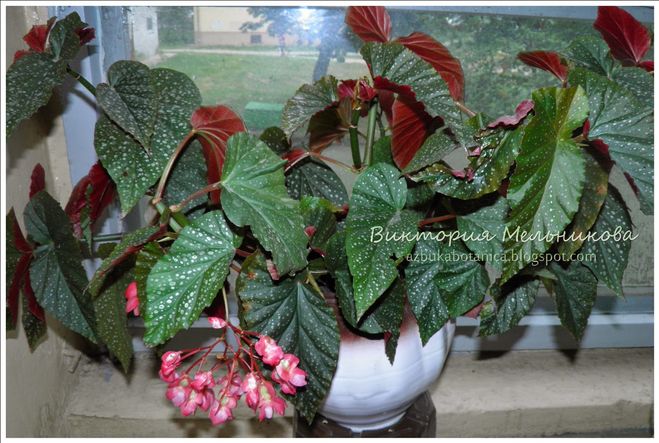

If I were you, I would cut the begonia to about the middle of the length (slightly below or above the middle - at your discretion) with a sharp knife or pruner, and after a week or two I would pass into a larger pot. If you don't want to prune, then just transplant. Add perlite and some sand to all-purpose peat. In general, this plant grows well in a mixture of leafy earth, tofr, sand and perlite, but if such a mixture cannot be made, then ordinary peat from a store will do. After 3-4 weeks, you can start feeding the plant with fertilizer for flowering plants, where nitrogen and potassium will be approximately in equal proportions, do not use organic fertilizers.
Provide the plant with bright, diffused lighting by placing it on an east or west orientation window, or shaded in a south orientation. Northwest and northeast windows will also work for this plant.
Coral begonia prefers a moderate temperature, so do not be surprised if in summer at temperatures above +25 degrees, being behind glass, where there is no air ventilation, it refuses to grow or sheds its buds.
I think that nevertheless your begonia will bloom, if only there is no stress, for example, cold drafts, sudden temperature changes, overdrying of the soil.
Begonia is a plant species that belongs to the Begonia family. There are a large number of species and subspecies, but conditionally they can be divided into two large groups: decorative and indoor, which in turn are divided into flowering (abundant flowering) and decorative deciduous (the flowers are mediocre, but the foliage has an unusual shape and bright saturated color).
Most often, a flowering begonia is grown at home, which manifests itself in three forms:
- evergreen;
- tuberous with falling leaves;
- bushy, requiring time to hibernate.
Home conditions are especially suitable for elatior begonias.
In order for begonia to grow and develop correctly, it is necessary to provide it with competent care:
- regular, at least twice a week, watering with pre-settled water;
- natural sunlight. This will provide rich colors for the leaves and flowers;
- natural organic fertilizer that can help the plant during flowering by providing it with essential nutrients;
- temperature regime of the order of 20 degrees.
Note! Even with proper care, problems can arise, such as a lack of flowering.
Leaves fall: what to do if leaves fall
If the plant sheds foliage, it means that something is missing. Massive leaf fall in winter means that the room is too cold and the begonia is freezing. For the flower to stop losing leaves, it is enough to increase the temperature.
It may also be that the leaves of the begonia wilted, as if you had not watered it for a long time. This problem occurs when the flower is located in the kitchen. It is harmed by the products of combustion of gas, so this is "treated" only by transferring the begonia to another room.
If the leaves become discolored before falling off, it means that a nematode has settled on the begonia. It is useless to fight it, so dispose of the plant and soil as soon as possible.
So, now you know how to properly plant and grow coral begonias, what problems can arise and how to solve them. Remember that most difficulties arise from improper care. Only some diseases can be transferred from other plants. For this reason, the conditions of detention must be observed so as not to spend money on means of combating diseases and pests.
Pests and diseases, methods of control and treatment
Excessive moistening of the soil of this type of plant and finding it in rooms with low air temperatures can lead to the fact that the plant will begin to suffer from gray rot or powdery mildew. This is evidenced by the appearance of brown or gray spots on the leaves. If such signs are found from the plant, all parts affected by pests should be immediately removed and sprayed with fungicidal preparations. For this purpose, you can use "Topaz" or "Vectra". After processing, do not forget to provide begonias with proper watering and temperature conditions. If the flower is located in a room with dry air, spider mites can attack it. To get rid of it, it is necessary to dilute one ampoule of "Karate" in two liters of water and spray the leaves with this solution. If the flower is affected by aphids, it is necessary to spray it with tobacco infusion at the rate of twenty grams per one liter of water.
Coral begonia cannot be called fastidious, therefore it has gained wide popularity among lovers of indoor floriculture. If you are not too lazy to carefully study the basic rules of caring for a Brazilian beauty, this plant will thank you with the appearance of beautiful pink flowers. Remember that the main enemies of coral begonias are over-watering, dry air and low temperatures.
Why you need to prune begonia
First of all, pruning begonias is needed for lush flowering and rejuvenation of the culture. Through this procedure, old and dry shoots are removed, the correct crown shape is formed, and the quality of flowering improves. With regular pruning, the correct ratio between the crown and the root system of the plant is ensured.
After transplanting a young plant, the first pruning is performed when it reaches a height of 7-8 cm. At the same time, the future shape of the crown should be determined, based on which certain parts of the branches are cut.


When the lateral shoots reach a length of 10-12 cm, their upper parts are carefully cut, thereby stimulating the development of lateral buds and contributing to the formation of a beautiful, rich bush. Further steps for the care are the timely removal of bent, dried shoots.
Why begonia doesn't bloom
Answering the question why begonia does not bloom, it is worth considering the main reasons:
- improper lighting, which is not enough for the flower to carry out the process of photosynthesis;
- unsuitable soil (correct soil - slightly acidic, loose and nutritious);
- incorrect transplant;
- insufficient amount of fertilizer;
- too dry indoor air or climatic influences, such as periods of drought;
- exposure to microorganisms that damage the root system or foliage;
- insufficient watering (this is the most important reason, because the roots of plants are most susceptible to moisture and its level should always be sufficient).
What kinds of begonias need pruning?
Pruning begonias at home is a responsible procedure that requires care and accuracy from the grower. When working, plant varieties are taken into account: some do not require such treatment at all, while others need regular and fairly frequent treatment to stimulate growth in width.


In the spring, bush plant varieties are predominantly thinned out, then begonias begin to grow actively. But as to whether it is necessary to prune begonias for the winter, experts have different opinions. For example, tuberous varieties need this procedure in mid-autumn, and until March the plant rests and recovers.
Begonia varieties such as royal rex, ever-flowering varieties and their hybrids are necessarily pruned. For thick-stemmed varieties, the procedure is done if necessary. And in ampelous begonias, only the apical stems are removed, thus stimulating the development of lateral shoots. Shrub varieties are usually cut in the spring when the plant sheds old foliage.
Is pruning necessary in winter?


In the autumn period, begonias pass into a passive vegetative period, so the number of waterings is reduced, and the ground parts with dried leaves are removed. Ideal conditions for wintering: a dark, cool place where the air temperature does not exceed 15 degrees. At the beginning of spring, when the growth of young leaves begins to be observed, the flowers come out of a state of dormancy, they can be returned to their usual places.
When and how long begonia blooms
How much begonia blooms depends on its type:
- The flower bed begins to bloom in June and this period can last until September, after which it can be transplanted into a home pot and brought indoors.
- homemade begonias, in particular the Elatior variety, begin to bloom in the fall and the process continues throughout the winter period.
Flowering depends solely on proper care and plant variety.
Begonia blooms differently, depending on the individual characteristics of the plant.
How to properly form a begonia bush
The growth rate and quality of flowering is directly determined by how correctly the begonia bush is cut and how it is formed. This should be taken care of even at the stage of early development:
- The first such procedure is performed when the plant reaches a height of 7-8 cm.
- In the subsequent period, the amount of watering decreases, it resumes when the flower begins to grow.
- After the begonia is pruned after flowering, the upper parts of the shoots that have reached a length of more than 10 cm are removed.


The desired crown shape is maintained by periodically shortening the elongated stems and removing dried shoots.
When is begonia pruning a must?
When performing these activities, the following factors are taken into account:
- in decorative deciduous varieties, flowering shoots are necessarily cut off;
- in order to avoid diseases in plants, damaged or dried shoots / leaves should be removed in time;
- for young crops, the procedure is used for decorative purposes, for the correct formation of bushes;
- for tuberous varieties, mandatory pruning for the winter is carried out.
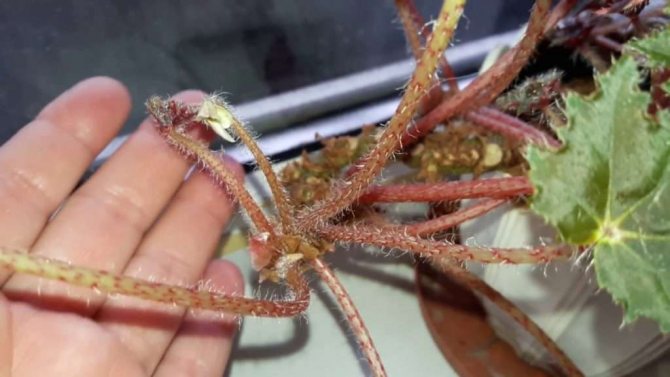

It is also allowed to pinch plants if it is impossible to carry out the usual procedure, while the plant needs to ensure the decorative effect of the crown. It is recommended to use sharp knives in the work, mainly garden knives. And here the use of scissors is undesirable: young shoots can be damaged and die as a result. The cut sites are processed with activated charcoal or charcoal.
What to do to make begonia bloom again
First of all, gardeners have a question of what to do to make begonia bloom. The answer is simple: change the conditions of care and cultivation.
Begonia does not bloom
Very rarely, the reason for the absence of flowers can be the age of the plant itself or the illiterate planting of the bush. In addition, when buying, you should carefully study the variety to which the begonia belongs, because the decorative leafy species, in principle, cannot bloom.
So, how to make a flower bloom - you need to provide the plant with a sufficient amount of moisture, but not excess. Introduce mineral nutrients into the soil - top dressing. Begonia will start to grow more actively and will soon give flowers. After that, transfer the plant to the windowsill, providing it with sufficient sunlight. It is worth protecting begonias from hypothermia, as well as from dryness. Room temperature will be just the way.
Now it is clear why begonia does not bloom and what to do with it. But this applies mostly to domestic, ever-flowering plants. But caring for a flower bed is slightly different:
- it should be noted that flowerbed begonia does not tolerate frosts well, therefore planting should begin no earlier than May;
- it is necessary to protect the plant from drought, while not neglecting the effects of direct sunlight in moderation;
- you need to rid the plant of a large amount of moisture, do not place it near wastewater or coming off the roof of the building.
The question often arises of why tuberous begonia does not bloom in a pot. The answer is simple and consists in proper watering, which is carried out only after the top layer of the soil has dried.
Cultivation and reproduction of Coral Begonia
The cultivation of Begonia in history may have happened so quickly because the plant reproduces very easily. In order to reproduce a home specimen, you need to know how to cut it. This is the only method available in modern conditions. Only a few breeders achieve fruiting from a variety in order to obtain new unique varieties. Let's find out how to propagate Coral Begonia using cuttings.
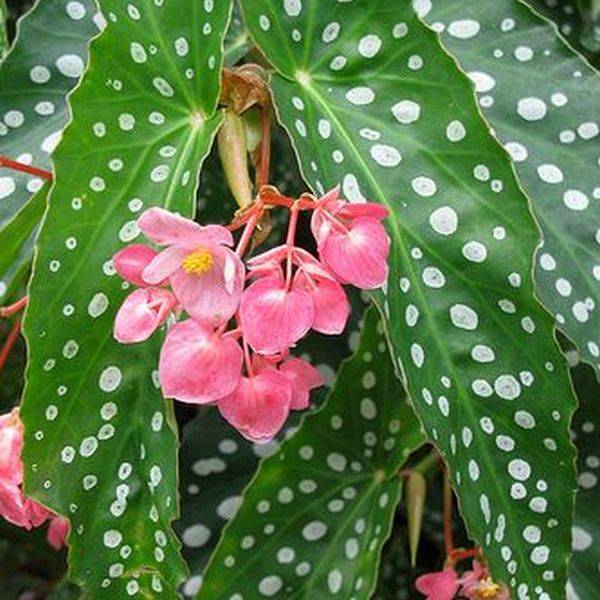

Like many others, the plant should start the reproduction process when the perennial is in the active growing season. For coral begonias, the optimal breeding time is summer and spring. Shoots are well equipped with nutrients and have sufficient sap flow for tissue regeneration.
Do not use flowering stems for grafting. In such shoots there is less strength, since all the juice and nutrients are aimed at maintaining active budding. The stems should not be too long. Cut the stalk under the bottom leaf so that the cut is slightly angled. We recommend the maximum height - no more than 10-15 cm, otherwise the stems will quickly lose strength. The lower leaves need to be removed, especially if you plan to root the plant in water. So they just start to rot.
Decide on a nutritional formula. Coral Begonia is remarkably rooted in water without the addition of various nutrients and root-forming substances. But, this method significantly increases the period of root formation. Therefore, I recommend using a substrate.
Also, there is a possibility that if you root a perennial in cold water, without changing it periodically, the plant will grow sick. It may not be immediately visible, but ailments will manifest over time. For example, shoots may start to grow randomly - in different directions, or the leaves may form an irregular shape.
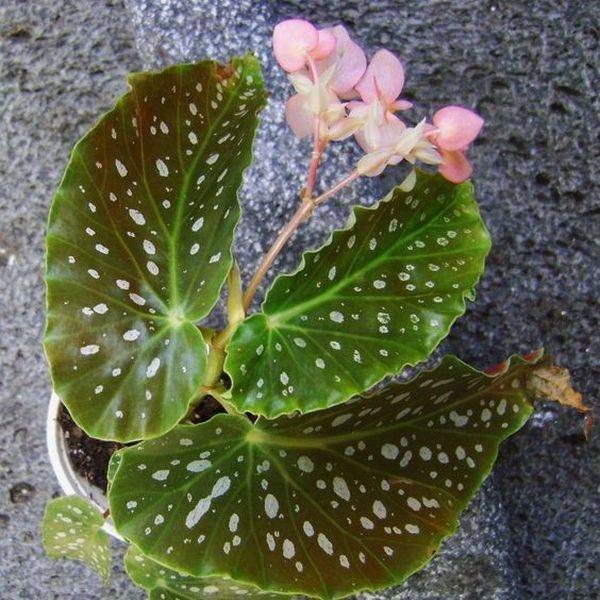

Take soil as a substrate. A composition based on nutritious peat mixed in equal amounts with river sand is suitable. The mixture, or better all separately, must be disinfected. This is especially true for sand. It is best to bake it in the oven. Cuttings are buried vertically into the nutrient mixture by no more than 2-3 cm.Now you need to create a certain microclimate. Rooting requires high humidity and a temperature of at least +18 degrees. Therefore, the handle is covered with a transparent cap.
Diseases and pests
Like any plant, begonia is not immune to disease and pest attacks. The main thing is to notice the problem in time and take appropriate measures.
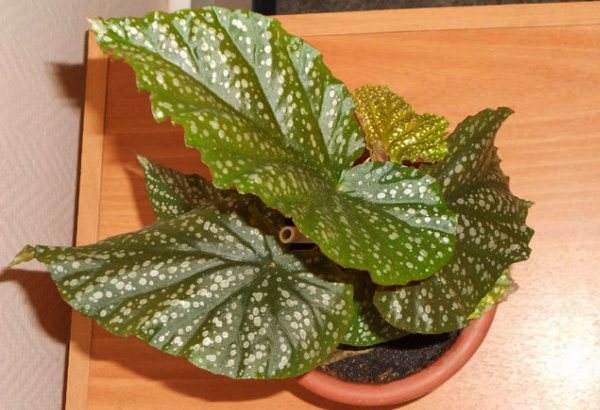

Gray rot
This fungus attacks the flower growing in hot and humid conditions. The first sign of infection is the appearance of white spots on the foliage, which soon turn into bloom. The latter gradually covers all the foliage, which is why the plant rapidly withers and withers.
First aid for gray rot - treatment with a one percent solution of Bordeaux liquid. In parallel, it is necessary to reduce the humidity in the room. If the effect is not followed, connect a stronger drug - "Fundazol". The latter is not recommended to be used indoors, and therefore, in the summer, processing is carried out on the street, in the winter - on the balcony.
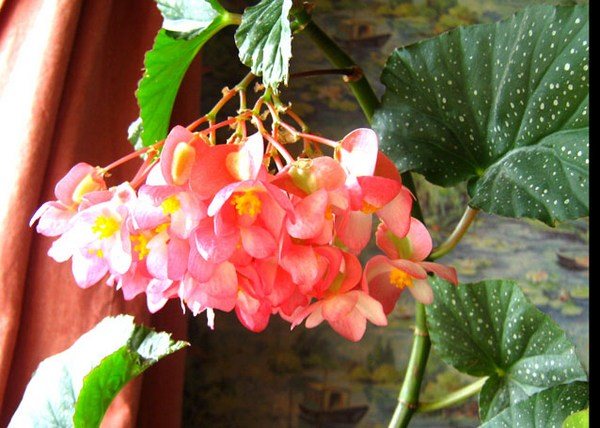

Bacterial spot
Pathogenic microbes in this disease provoke the appearance of small spots on the leaf plates. The plant is disposed of along with the soil, since the disease cannot be treated. The pot is then repeatedly treated with strong disinfectants or boiled.
Preventive treatments of begonia with copper chloride (5%) will help prevent the disease. They are carried out twice with an interval of 2 weeks.
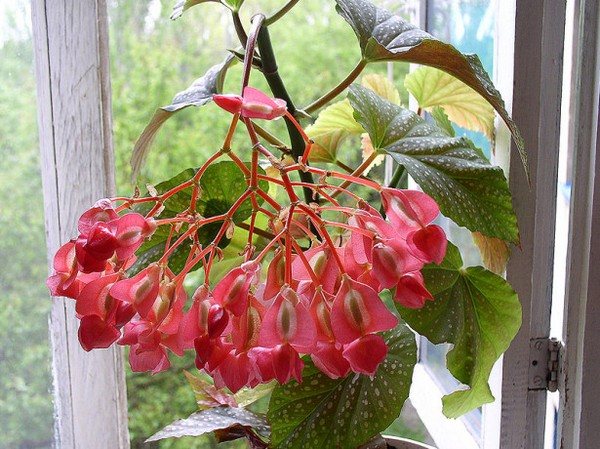

Shields
These are small oval insects that often attack houseplants. They are easy to spot and remove without damaging the flower. The appearance of this pest is identified by the presence of a specific sticky plaque on the shoots and leaves.
To combat scale insects, insecticides are used, for example, Actellik.
Spider mite
Small harmful insects usually hide on the inside of the leaves, so they are sometimes difficult to find. The mite weaves a web - the main identification mark for flower growers. In the latter, he lays eggs.


The mite sucks the juice out of the plant, and therefore the appearance of large colonies of pests leads to dehydration of the plant and its subsequent death.To combat ticks, the same drugs are used as with the scabbard.
Note. Small colonies of spider mites are destroyed with a strong soapy solution.
Why does foliage fall?
If the plant sheds foliage, there may be several reasons: a lack of nutrients, a drop in room temperature, drying out of the soil in the absence of regular watering.
In addition, coral begonia does not tolerate the products of gas combustion. An unfavorable atmosphere can provoke illness and foliage.


Discoloration of leaves with their subsequent death is a sign of nematode damage. It is urgent to take action by disposing of the soil and the plant. It is impossible to cure this disease.
With the necessary knowledge of planting, growing coral begonias, and pest control, it is easy to grow a healthy plant. And then it will certainly delight the eye with its lush and long flowering.
Below you will see interesting details of caring for this indoor flower:
How to properly care for this houseplant?
Coral begonia will tolerate lack of water more easily than excess water, so watering the plant is necessary, making sure that the topsoil is completely dry. Water should be more abundant in summer. The fleshy leaves of begonia at high temperatures quickly lose moisture, and this can lead to the death of the beauty. The temperature regime for begonias is optimal in the range from 17 to 25 degrees... It is advisable not to place the plant near the vents or in places of through ventilation, because this can negatively affect the development of begonia.
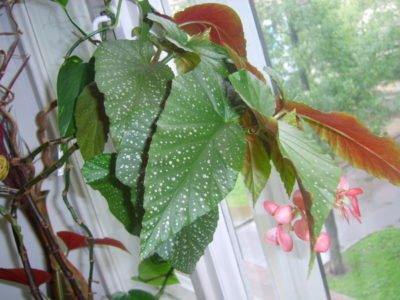

When watering 2 times a month, it is advisable to add a potassium solution of fertilizers to the water. To obtain the necessary care, the soil in the pot must be renewed annually. In the spring, you can feed begonia with phosphorus fertilizers, but no more than twice a month.
If the plant is young, then at the beginning of summer it is advisable to transplant it into a large container. The transplant is best done the next day after watering. However, when choosing a pot, it is worth considering the following: a large amount of unused land leads to putrefactive processes. Adult begonias do not need frequent replanting; this process can be replaced by replacing the topsoil.
She also needs pruning. If, when caring for the plant, you do not form a bush, then the elongated stems will negatively affect the appearance of the begonias. Therefore, it is worth pruning the shoots after the third internode to stimulate the growth of the lateral branches. Cuttings can be used to propagate begonias.
After flowering, it is necessary to cut off dry twigs and brushes, otherwise begonia will begin to lose nutrients.
Photo
Here you will see a photo of this beautiful plant - coral begonia:
You can get acquainted with other varieties and types of this beauty without leaving our website. Read about such varieties of this plant as Fista, Royal, Rex, Cleopatra, Griffith, Bauer, Terry, Elatior. There you can also learn more about varieties with red and yellow flowers.
Features of the growth and development of begonia
Coral begonia for several years grows up to 1 meter in height up to 50 cm in width. If you provide a favorable climate and proper care, this flower will grow rapidly. A perennial plant takes root well in loose, peaty soil. It is better to choose a medium-sized begonia pot.
Summer flower it is necessary to properly moisturize and systematically feed... For begonias to grow, moderate heat and sufficient air humidity are needed.
Therefore, it is recommended to regularly humidify the air around the plant, but avoid getting moisture on the leaves.
For the appearance of new flowers, you should remove systematically old dried inflorescences... Long stems are also trimmed neatly. They, if necessary, can be used as propagation cuttings.
Coral begonia can be affected spider mites, to combat which systemic insecticides are used.
Young coral begonia plants are transplanted annually in early summer or late spring. The new container should be 2 cm larger than the previous one. There should not be a lot of unused land, because putrefactive processes arise in it. Transplanting adult begonias is performed less frequently and is carried out more delicately: replacing the top layer of the earth or by transshipment.
When forming a begonia bush, pruning should be done after the 3rd or 4th internode. This stimulates the development of lateral branches. In addition, after each flowering, it is necessary to cut off dried brushes so that the plant does not lose strength.
Growing conditions
For this flower, home care is required uncomplicated. The main thing is to comply with certain conditions:
- The soil... A common mixture of garden soil, coarse sand, dry peat and compost is suitable for planting a plant. Alternatively, you can purchase a special violet mixture. The planting container must have a drainage layer up to 2 cm and a hole for water outflow. Pieces of broken brick, gravel or foam are used as drainage material.
- Illumination... It is strictly forbidden to place begonias in direct sunlight. The plant in such conditions can get burned, which will negatively affect the development and appearance. The best location for coral begonias is a window sill on the west, north, or east side. However, in winter, it is better to rearrange the flower on the south window to provide it with maximum light.
- Watering... It is necessary to water the coral begonia only when the topsoil dries out by 2 cm. You cannot deprive the plant of moisture or flood it. Both the first and second will negatively affect the formation of buds. When the shrub is in bloom, the soil should always be moist. In order not to spoil the aesthetic appearance of the leaves, do not spray the plant. It is better to put a container of water next to the pot.
- Temperature... The optimum temperature for a plant is 14-25 ⁰С. It is dangerous if the temperature drops below 13 ° C. Drafts have a very negative effect on the development of the flower. Therefore, you cannot put it near a door or window.
- Top dressing coral begonias should occur in spring and summer once every 14 days, in winter - in autumn once every one and a half months. Liquid fertilizers should be used.
- Pruning is also included in the mandatory steps when caring for a plant. To form the aesthetic appearance of the bush, it is necessary to pinch the upper shoots. This will cause the bush to sprout with leaves on the sides, and the begonia will go in breadth, not upward.
General characteristics of coral begonia
In total, about 1500 species and varieties of this plant are known. But it is coral begonia that is most popular among both beginners and experienced florists.
Its vibrant flowers refresh small spaces, rooms and spacious, roomy greenhouses. Sometimes begonias are called Angel Wings because of their large, elongated and drooping leaves.
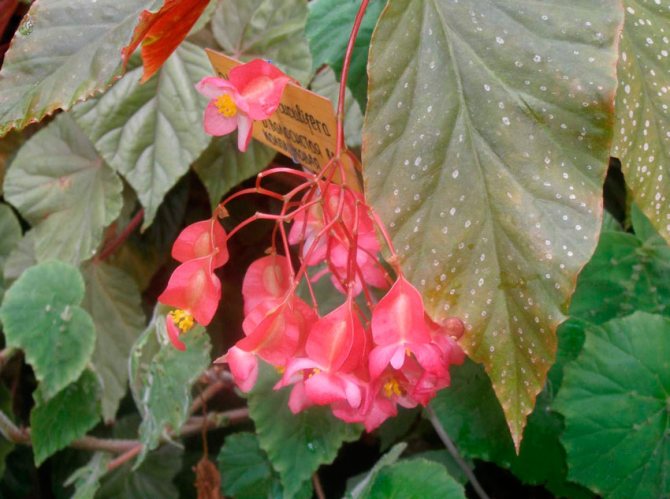

1. Seven Secrets of Success:
| 1. Growing temperature: throughout the year the ideal temperature range is between 18 and 24 ° C, during the winter months the indoor temperature should not fall below 13 ° C. |
| 2. Lighting: Shade from direct sunlight during hot daytime hours in spring and summer. |
| 3. Watering and humidity: Dry the soil 1.5 cm deep between waterings, increase the humidity with a room humidifier or a tray with wet pebbles. |
| 4. Pruning: Trim old yellowed leaves and remove wilted flowers. |
| 5. Priming: nutritious, well-drained substrate. |
| 6. Top dressing: every week with mineral fertilizers in half concentration, in winter you can feed it monthly. |
| 7. Reproduction: leafy and apical cuttings rooted in spring and summer. |
Botanical name: Begonia x corallina.
Family... Begonias.
Homeland of the plant. South America.


Coral begonia description. These plants look great all year round. Even in the absence of flowering, elegant leaves, cascading stems cascading down will attract attention. The leaves are large, glossy, green, often spotted with white, large specks and a reddish underside. The flowers just add extra showiness to this begonia. The flowering time is different for each variety, but most of these plants bloom in the spring. Flower shades range from pale pink to deep red. They are some of the most spectacular plants in the world and some of the simplest begonias to cultivate.
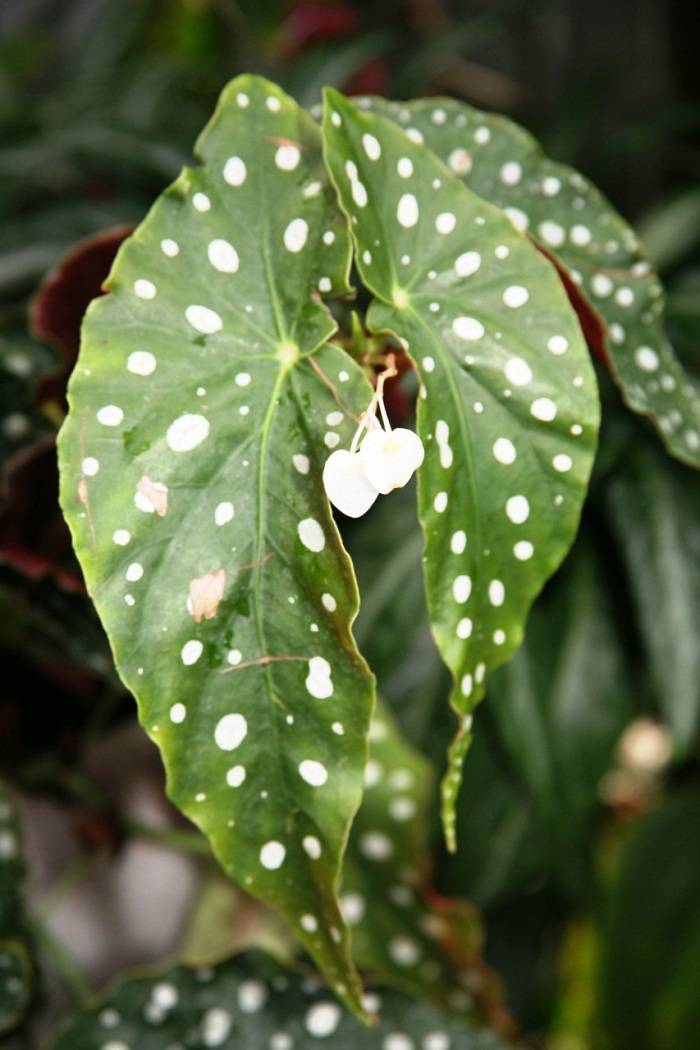

Height... Up to 90 cm in height.
Breeding features


Coral begonia reproduces easily at home. Several breeding options are possible:
- A leafy stalk about ten centimeters long should be placed in water (or wet sand). When the roots that appear have reached one and a half centimeters in length, the stalk must be transplanted into the ground. You can accelerate growth by covering the container with the handle with a glass jar (this is how greenhouse conditions are simulated).
To avoid the development of a fungal disease in a young plant, it is necessary to powder the place of contact of the cutting with the soil with wood ash.
- To propagate a plant with leaves, it is necessary to make cuts on the back of the leaf, lay the leaf on a damp substrate and cover with a film. From time to time it is necessary to cut off the parts with the formed roots, leaving some for further growth.
- When transplanting, you can divide the rhizome. This is not only a breeding method, but also an adult begonia rejuvenation procedure.
Country of origin and homeland of the houseplant begonia
Coral begonia, aka coralline, is an upright species of ornamental indoor plants belonging to the genus Begonia.
Coral begonia is native to Brazil. In tropical forests, a flower can grow up to 1.5 m in height, and at home - 0.6-1 m.
The leaves, which have a regular arrangement, are colored in different shades of green. They reach 7 cm in width and 20 cm in length. Their leathery surface is covered with milky and silvery specks. They have a rugged and elongated oval shape. In bright light and in summer, their back side takes on a juicy crimson color.
Flowers consist of 3 or 4 fused petals, which come in different colors:
- orange;
- red;
- pink;
- white.
They are collected in inflorescences similar to bunches of berries. Flowers of this kind of begonia smell good and taste good too.
The discoverer of begonia is the botanist Charles Plumier. During a trip to explore the Antilles in the 17th century, he saw this unusual flower. Charles Plumier named this plant in honor of the Governor of Haiti, Michel Begon, who donated funds for the expedition.
Probably there is no person who is fond of floriculture who would not know anything about begonias. In Russia, this southern visitor has long and firmly settled on the windowsills, thanks to the unpretentiousness, beauty of flowers, a variety of their shapes and shades. But not everyone knows where the birthplace of this plant is.
Due to the species diversity, it has become an adornment not only for houses and apartments, it feels very comfortable in summer cottages, in gardens and parks, and has become widespread in many countries of the world.
Even during the war of 1812, they began to call it "Napoleon's ear" in Russia, since the leaves of the plant resemble frostbitten ears in shape.
A resident of the rainforests of South America, Asia and Africa, begonia is represented by more than 900 species. The plant can be decorative deciduous, decorative flowering or shrub.
Where does the indoor flower come from and how did it get to us in Russia? For the first time this species was described by the French priest S. Plushier, who discovered a new plant during his travel to the places of Haiti.
The governor of the island at that time was Michel Begon, it was to him that the flower owes its name - this is the origin of the name of the plant.
Begonia native to the island of Haiti
Due to the abundance of species and high decorativeness, the brought new product quickly gained popularity among European florists.
At first, begonias were grown in greenhouses. After, thanks to the efforts of breeders who managed to get varieties that feel comfortable in a far from tropical climate, the flower moved from greenhouses and from window sills to gardens and parks, over the years not only not losing its popularity, but also significantly strengthening it.
Now begonia is widespread in Asia, Europe, Africa and America, that is, it gives its beauty to residents of almost all continents.
It has become popular with flower growers in many countries and decorates not only the interiors of houses and apartments.
Begonia is an excellent decoration for parks and a favorite of landscape designers who appreciated its exceptional decorativeness.
There is a very beautiful legend about this amazing flower. The Atzalca Indians of South America have long worshiped the Tamaya plant. It was considered sacred to the tribe.
Once a year, the goddess of Heaven descended to Earth and the plant became a young woman of amazing beauty. The golden-haired beauty was a symbol of the union between Heaven and Earth.
After the discovery of America by Columbus, the life of the Indians turned into a nightmare. The last hope for them was the help of the golden-haired goddess. The natives believed that she was able to return them to their old happy life.
With the help of ritual dances and songs, the Indians managed to summon the goddess, but the beauty was captured by the Spaniards and locked up on a ship sailing to Europe.
During the entire journey, they tried to seduce the goddess more than once, promising rich gifts in exchange for favor, and when, having arrived in Spain, they opened the cabin door, instead of the girl, they found only a long dried stem without flowers and leaves.
The flower can be grown in a greenhouse, at home, and in the open field.
Frightened by what they had done, the head of the conquistadors vowed to return the sacred flower to his homeland. He placed "Tamaya" in a crystal urn, but did not have time to return to America, since he died.
Several centuries later, an urn with a flower and a recorded story of the conquistador were accidentally found by a French botanist who managed to return the dried stem to his homeland.
With the first rays of the sun, the stem turned into a golden-haired beauty, which immediately disappeared, and the plant revived to life, covered with flowers and leaves. Tamaya has returned home.
Magic and astrology
According to popular belief, this inhabitant of the tropics brings happiness and prosperity to the house. Helps its owner to avoid financial problems and find a soul mate.
However, it should be remembered that diseases of these flowers can portend trouble for household members. Therefore, not only the condition of your green pet, but also the excellent condition of all family members depends on caring care.
You shouldn't take these flowers from someone who doesn't treat you well. Together with them, you can get a lot of negativity.
The southern beauty absorbs negative human emotions, takes away unpleasant thoughts, relieves insecurity and harmonizes relationships. She can return the former passion to partners who have been married for many years.
That is why he is able to give a fading relationship a second life and help those who have already despaired and resigned to loneliness to find love.
Some are afraid to keep begonias at home due to the fact that blossoming at the wrong time, it portends the death of one of the family members.
This superstition has spread only in Russia. In other countries, she is credited with exclusively positive qualities.
Begonia brings happiness and well-being to the house
Believe it or not in such possibilities of a green handsome man is a private matter for everyone, but, in addition to magical abilities, he also has healing properties:
- the ability to quickly heal wounds;
- is an excellent antiseptic;
- has antiallergenic and antispasmodic effect;
- good pain relief.
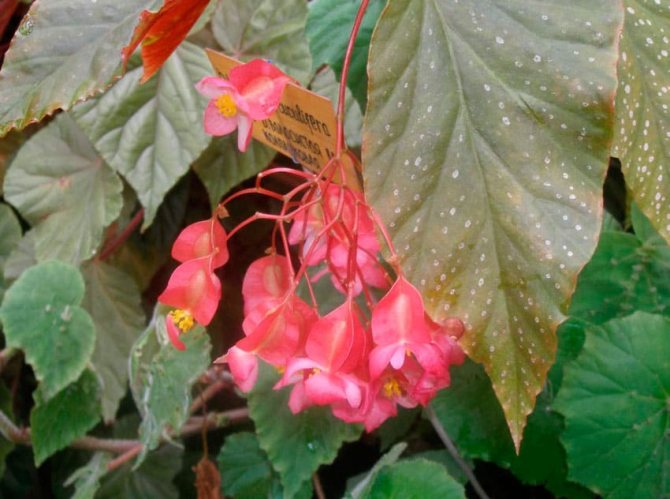

In addition, it perfectly cleans the air from dust and neutralizes harmful radiation. It has a beneficial effect on people prone to colds and respiratory diseases.
Tip: place a pots with these flowers near the computer, it will get rid of harmful radiation just like a cactus. In addition, begonia leaves absorb dust, purifying the air.
Orange tones can help relieve depression and improve mood. Yellow ones are able to relieve eye fatigue, red ones - activate life processes.
Begonia flowers have medicinal properties, the leaves absorb dust, purifying the air
Even a small plant has extremely positive energy. With his appearance in the house, the aura of the home changes, becoming more positive.
Begonia can improve the financial condition of its owners. You just need to tell the flower about your problems and ask for help. In gratitude for the care and concern, begonia will definitely increase cash flows in the house.
According to the now fashionable Chinese teaching Feng Shui, it is also a symbol of wealth, family happiness, tranquility and well-being. In Asia, begonias adorn the head of the bride with red flowers, they serve as a guarantee of the undying passion of the future union.
Tip: When cooling the relationship, put a begonia with red flowers in the matrimonial bedroom. Soon you will feel the return of the former ardent feelings.
It is the abundance of species that has made begonias so popular. It can satisfy both a lover of beautifully flowering plants and a person who prefers to see plants with leaves of exotic colors in their home.
It will help to decorate and make a unique suburban area. For many centuries, it has been pleasing people with its beauty and giving a good mood.
Where and how to plant?
To plant a coral begonia, you need a pot with holes in the bottom. Then excess water will not accumulate, which means it will not lead to decay.
At the bottom, it is necessary to organize a 2 cm drainage layer of any material:
- pebbles;
- broken brick;
- gravel;
- expanded clay.
Its top width should be greater than the bottom width. It is best to take clay, which heats up slowly and does not contain harmful impurities. You cannot put vases with coral begonia in direct sunlight on the loggia, open air and window sills, otherwise there will be burns on the leaves.
Lighting and location
Coral begonias need diffused light and do well in shade. In winter, the flower can not be removed from the window if it does not blow from it. The window sills of the eastern, western and northern sides are considered the best place. The flower should not be placed near heating appliances and open vents. He loves warm air without wind.
Deficiency of light on coral begonias is reflected negatively. It leads to stunted growth and development of the plant.
Soil requirements
To plant a flower, you can buy a ready-made soil mixture or mix 2 parts of ordinary garden soil and 1 part each:
- peat;
- compost or humus;
- coarse sand.
It is important to note that gravel, styrofoam, or pieces of broken brick can be used as drainage.
Common diseases
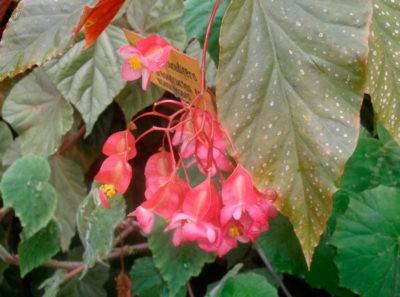

Coral begonia is susceptible to several diseases. The most common ones are:
- Shield- the leaves become sticky, brown spots appear on them.
Treatment: treat the plant with Aktara or another insecticide. - Vascular bacteriosis - leaves wither at the edges, but remain green. Brown spots are covered with oily droplets. The vessels of the plant in the infected leaves turn black.
Treatment: at the initial stage, the affected parts are removed, and the begonia is sprayed with preparations of the fungicide group. - Gray rot - the leaves become covered with sticky watery spots with a gray coating, the leaves and stem begin to rot.
Treatment: the affected parts are removed, the air humidity is reduced, sprayed with a 0.1% solution of Fundadal, 0.2% topsin solution, 0.1% euparen solution. - Powdery mildew - leaves are covered with spots with a white bloom.
Treatment: the plant is isolated, sprayed with Fitosporin-M, Alirin-B, with severe infection - Topaz, Strobin.
What is cropping?
What is it done for?
Pruning is the process of partial or complete pruning of stems in order to regulate growth and flowering. Due to the correct pruning, you can not only increase the decorative effect of begonias, but also increase its lifespan. So what to do is not only advised, but rather recommended. This will preserve the decorative properties of begonia, as well as maintain its health.
Pinching
Pinching is the process of cutting off the tops of the shoots and buds that are located at the end of the branches. The answer to the question "Can I pinch?" will be unambiguously "Yes". Further, it will be described in detail how and when to do this.
Characteristics of species and varieties of crops
Begonia: care
There are many varieties of begonias:
- ever flowering - got the name because of the length of the flowering period;
- liana - the main stem of the plant is liana-like, in length it can reach 2.5-3 m. Growing up, the shoot clings to any objects. Under natural conditions, it is most often attached to tall trees;
- deciduous - they do not have aerial shoots, and the leaves are located in the root zone. This plant looks very beautiful thanks to its large leaf plates, which differ in shape and color;
- bush - in this species, shoots grow well, forming bushes of various height and volume. The main varieties of spray begonias are coral (including Angel Wings begonias) and fuchsia;
- tuberous - begonias of this species have a characteristic root in the form of a tuber.
Pests
- False shield - begonia is weakened, blooms poorly, the leaf brightens and deforms, a bloom of a sugary look is observed. The insect that struck the plant is transparent, covered with a yellowish waxy coating, up to 5 mm in size. The false shield and its larvae populate the edges of the leaf and feed on the sap, which entails its weakening and death.
Protection methods:- spraying with any pesticide for indoor plants;
spraying with garlic setting (10 grams of garlic per 1 liter of water, repeat spraying after 12-14 days).
- Aphid - the leaf turns yellow, on its underside, clusters of oval-shaped insects up to 2.5 mm in size are clearly visible, the color is yellowish or greenish. The insect and its larvae feed on sap, weakening the plant, and can carry dangerous viral diseases.
Protection methods:- spray with any insecticide;
spray with a solution of laundry soap (20-30 grams per 1 liter of water);
- spray with makhorka mood (20 grams per 1 liter of water, leave for two days).
- Double wing - the leaves turn yellow, on their underside you can find insects up to 1.5 mm in size with two pairs of wings covered with a white bloom.
Methods of protection: regularly spray with a solution of laundry soap (40 grams per 1 liter of water). - Thrips - begonia lags behind in growth, the leaves become discolored, turn yellow, brown insects up to 1.5 mm in size with two pairs of wings can be seen on them.
Protection methods:- spraying with a solution of laundry soap;
spraying with infusion or decoction of tobacco (100 grams per 1 liter of water).
- Hallow's nematode - causes decay of the root system and death of the plant, begonia slows down in growth. A worm up to 1.2 mm long inhabits the roots and the lower part of the stem.
Method of protection: pour heterophos at the root. - Nematode - light spots appear on the leaves, the shoots thicken, severely affected specimens die.
Method of protection: treat the plant with a heterophos solution.
Transfer
In the spring or in the first weeks of summer, young representatives of coral begonias are usually transplanted. The pot should be taken a little more than the previous one, so that there is not a lot of extra land. Often, it is there that the processes of decay or the emergence of harmful microorganisms begin.
Adult plants do not require such frequent transplanting, and the procedure should be carried out carefully - just transferring the plant to another pot and adding fresh substrate.
It is necessary to replant only the next day after watering. It is not recommended to touch the plant during active flowering or after abundant watering.
Varieties
There are more than a thousand species of begonias, but there is still no generally accepted classification of the plant. According to one of the options, the following conditional directions can be distinguished:
- Decorative leafy begoniasthat do not have a common above-ground stem. Leaves grow from a branched root.
- Tuberous begoniascharacterized by a tuberous rhizome, fleshy tall stems and simple flowers.
- Beautiful flowering begonias - Plants with beautiful simple and double flowers of various colors.
- Shrub begonias, which are bushes with numerous side shoots. Coral begonia belongs to this species.
Here you will see a photo of this beautiful plant - coral begonia:
Use in landscape design
Coral begonia, pelargonium and balsam complement each other in the interior of the room. An interesting composition is easily composed of them, in which each flower looks very impressive. You can place the pots horizontally in a common stand or an elongated drawer, as well as vertically on divider shelves, high stands equipped with rings or shelves at various levels. In a room, the plant can be placed in a free corner to soften the vertical.
If you adhere to the simple rules of caring for this Brazilian beauty, then she will give you beautiful flowers, create a festive atmosphere and a favorable microclimate in your apartment.
Reproduction
Cuttings (sheet)


Reproduction by cuttings is carried out in spring or summer according to the following scheme:
- Cut off a large healthy leafy cutting from the middle of the stem: from a young plant - no more than 9 cm long, from an adult (over 4 years old) - up to 15 cm. It is better not to use it from the bottom. There should be no ovaries and flowers on the cutting, otherwise budding will begin, taking away all the vital forces from the cutting (after the formation of flowers, it will die).
- Place the cutting in a glass of clean water at room temperature (or in a mixture of coarse river sand and peat). There is no need to add any stimulant. Wait for 1 cm roots to appear.
- Transplant the cuttings into prepared pots (with substrate and drainage layer).
Seeds
Seeds are planted in winter (from December to March), in leafy soil mixed with sand and peat. The seeds do not blot out, but only slightly press into the soil... The first shoots can be expected in a couple of weeks. The sprouts are planted in separate plastic cups, and then in pots. If the seed material is healthy and you have carefully looked after the seedlings, you will be able to admire the first flowering already in July.
By dividing the bush
Tubers for future planting will be fully formed by autumn. They are cleared of the earth, the foliage is cut off. The tuber is divided into parts and placed first in peat, and then in the sand, buried. The sand should be watered sparingly.
You can store tubers in the same sand, at a temperature not lower and not higher than +10 degrees.
Features of growing and care
Although the plant is unpretentious, some rules should still be followed when planting and growing. Let us consider in more detail what conditions will be the most comfortable for this type of begonias.
Soil composition
You can prepare the soil yourself as follows: mix peat, compost, river sand and ordinary garden or vegetable garden soil. If you live in a city, then get ready-made soil for violets or universal.
Sometimes the following composition is used:
- Sheet soil - 2 parts.
- Humus - 2 parts.
- Coarse sand - 1 part.
A drainage layer several centimeters thick should be placed at the bottom of the pot. It can be composed of gravel or small stones. At the very bottom, holes are provided for the outflow of water and ventilation.
For looseness, perlite, vermiculite and granular foam can be added to the soil. All ingredients should be mixed well.
The flower loves light, nutritious and moisture-permeable soil. The abundance and frequency of flowering depends on its composition. In too wet soil, begonia will simply not bloom.
It is better to purchase a pot made of natural material, for example, clay is suitable. The width must necessarily be greater than the bottom. Resilience is very important for this flower. Select the size by 4 -5 cm larger than the size of the root system.
If you change the substrate every year, then the need for fertilizing and fertilization disappears. The only way to fertilize the plant is potassium humanate, which promotes more active growth and flowering of begonia.
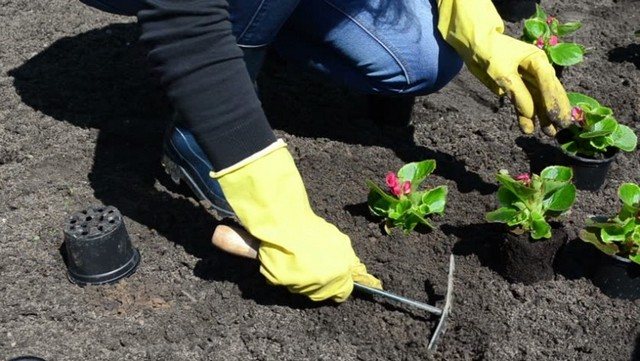

The north or east side is the best place for this plant. Direct sunlight of begonias is contraindicated, as they can burn the leaf plates.
The plant also tolerates partial shade or diffused lighting well. During the winter months, it is recommended to move the flower pot to the south side, because at this time of year the sun will not be enough for it due to the short daylight hours.
Many growers try not to place the flower in the fresh air, on window sills or balconies, so that the sun's rays do not injure the plant.
Temperature regime
Indoor temperatures from + 18 to +25 degrees are considered the most suitable for coral begonias. And if the thermometer shows less than 12-13 degrees Celsius, then the plant should be immediately transferred to a warmer room, because it can simply die.
It is not recommended to place the flower under open windows, vents and in drafts. It is categorically unacceptable to place a flowerpot under an air conditioner and a fan - from this the flower begins to ache.
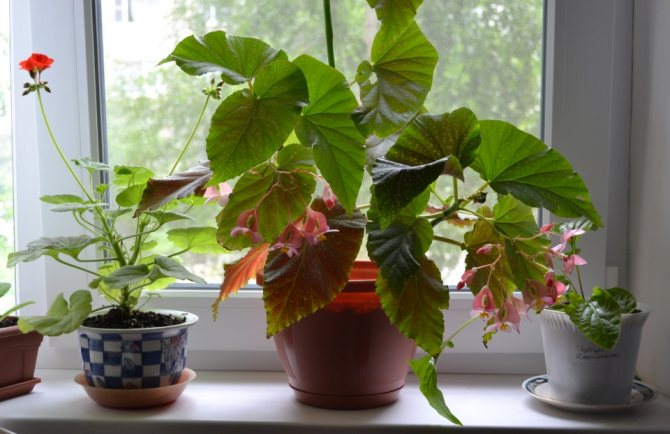

Watering features
Soil moisture should be very moderate. It is better not to pour coral begonia, because stagnant water and constant excessive moisture can lead to root rot and death of the plant.
- Dry soil can also negatively affect flower growth. Watering should be done if the topsoil has dried out by a few centimeters. Water for humidification should be used standing, at room temperature or slightly warm.
- In winter, watering should be limited a little, especially if the room is not very warm. This can provoke freezing of the root system.
- Experts do not recommend spraying the plant so that spots do not appear on the leaves that will spoil the appearance.
If the air in the room is too dry, or when batteries or other heating devices are turned on in winter, simply place a container of water next to the flowerpot. Spraying of nearby plants is allowed, if the peculiarities of caring for them require it.
Failure to comply with the temperature regime and watering (hypothermia, "flooding" of the flower) often provoke the appearance of gray rot and powdery mildew in the plant, which will have to be treated with fungicides.
How to properly prune coral begonia
- Both sanitary pruning is allowed, when diseased, broken or dry shoots are eliminated, and rejuvenating: with it, the tops of the stems are pinched. Then the flower actively grows in width thanks to new shoots.
- The bush can be shaped as a ball or pyramid if desired.For this, the aerial part is formed, the main stems are shortened. You can finally finish the process when young shoots grow up.
- Pruning is carried out when the length of the main shoots reaches at least 10 cm. In the first weeks of spring, it is recommended to shorten the branches to a height of no more than seven centimeters so that the begonia rejuvenates and gives new ones.
- Pruning should be done with a sanitized, sharp knife so as not to damage the top layer of the stem.
- If the stem is too thick and dense, then it is better to remove only the apical shoots.
- After all procedures, it is not recommended to change the air temperature, so as not to cause additional stress to the plant.
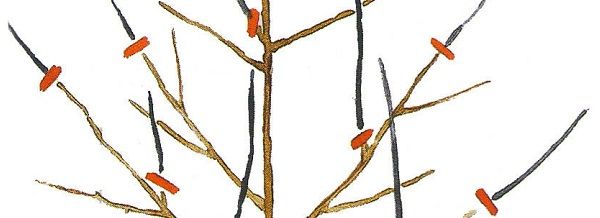

In the spring or in the first weeks of summer, young representatives of coral begonias are usually transplanted. The pot should be taken a little more than the previous one, so that there is not a lot of extra land. Often, it is there that the processes of decay or the emergence of harmful microorganisms begin.
Adult plants do not require such frequent transplanting, and the procedure should be carried out carefully - just transferring the plant to another pot and adding fresh substrate.
It is necessary to replant only the next day after watering. It is not recommended to touch the plant during active flowering or after abundant watering.

